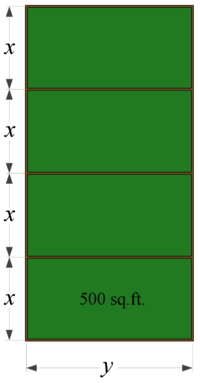Difference between revisions of "009A Sample Final A, Problem 7"
Jump to navigation
Jump to search
m |
|||
| (6 intermediate revisions by the same user not shown) | |||
| Line 10: | Line 10: | ||
|As a word problem, we must begin by assigning variables in order to construct useful equation(s). As an optimization problem, we will be taking a derivative of one of our equations in order to find an extreme point. | |As a word problem, we must begin by assigning variables in order to construct useful equation(s). As an optimization problem, we will be taking a derivative of one of our equations in order to find an extreme point. | ||
|} | |} | ||
| − | '''Solution:''' | + | '''Solution:''' |
{| class="mw-collapsible mw-collapsed" style = "text-align:left;" | {| class="mw-collapsible mw-collapsed" style = "text-align:left;" | ||
!Step 1: | !Step 1: | ||
|- | |- | ||
| − | |'''Declare Variables:''' We are attempting to find the dimensions of a single pen, such that we use as little fencing as possible for all four pens. Let's use | + | |'''Declare Variables:''' We are attempting to find the dimensions of a single pen, such that we use as little fencing as possible for all four pens. Let's use <math style="vertical-align: 0%;">x</math> and <math style="vertical-align: -18%;">y</math> as indicated in the image, and simply call the length of fencing required <math style="vertical-align: 1%;">L</math>. |
|} | |} | ||
| Line 21: | Line 21: | ||
!Step 2: | !Step 2: | ||
|- | |- | ||
| − | |'''Form the Equations:''' Notice that we need fencing between each of the pens | + | |'''Form the Equations:''' Notice that we need fencing between each of the pens, so we require a total of <math style="vertical-align: 0%;">5</math> pieces of length <math style="vertical-align: -18%;">y</math>. We also need <math style="vertical-align: 0%;">2</math> pieces of length <math style="vertical-align: 0%;">x</math> for each pen, which means there are a total of <math style="vertical-align: -5%;">4\cdot 2</math>   pieces required of length <math style="vertical-align: 0%;">x</math>. Together, we need a total length of <math style="vertical-align: -18%;">L=8x+5y</math>. |
|- | |- | ||
| − | |On the other hand, we know that each pen has a fixed area of 500 square feet. Thus, we also know that | + | |On the other hand, we know that each pen has a fixed area of <math style="vertical-align: 0%;">500</math> square feet. Thus, we also know that <math style="vertical-align: -18%;">xy=500</math>. |
|} | |} | ||
| Line 29: | Line 29: | ||
!Step 3: | !Step 3: | ||
|- | |- | ||
| − | |'''Optimize:''' Since | + | |'''Optimize:''' Since <math style="vertical-align: -18%;">xy=500</math>, we also know <math style="vertical-align: -21%;">y=500/x</math>. Plugging this into our equation for length, we have |
|- | |- | ||
| <math>L(x) = 8x + 5\cdot \frac{500}{x} = 8x + \frac{2500}{x}.</math> | | <math>L(x) = 8x + 5\cdot \frac{500}{x} = 8x + \frac{2500}{x}.</math> | ||
| Line 45: | Line 45: | ||
| <math>y =\frac{500}{25\sqrt{2}} = \frac{500\sqrt{2}}{25} = 20\sqrt{2}. </math> | | <math>y =\frac{500}{25\sqrt{2}} = \frac{500\sqrt{2}}{25} = 20\sqrt{2}. </math> | ||
|- | |- | ||
| − | |Thus, the least amount of fencing is used when we size our 500 sq. ft. pens as | + | |Thus, the least amount of fencing is used when we size our <math style="vertical-align: 0%;">500</math> sq. ft. pens as <math style="vertical-align: -8%;">20\sqrt{2}</math> feet by <math style="vertical-align: -22%;">25/\sqrt{2}</math> feet. |
|} | |} | ||
[[009A_Sample_Final_A|'''<u>Return to Sample Exam</u>''']] | [[009A_Sample_Final_A|'''<u>Return to Sample Exam</u>''']] | ||
Latest revision as of 08:53, 2 April 2015
7. A farmer wishes to make 4 identical rectangular pens, each with
500 sq. ft. of area. What dimensions for each pen will use the least
amount of total fencing?
| Foundations: |
|---|
| As a word problem, we must begin by assigning variables in order to construct useful equation(s). As an optimization problem, we will be taking a derivative of one of our equations in order to find an extreme point. |
Solution:
| Step 1: |
|---|
| Declare Variables: We are attempting to find the dimensions of a single pen, such that we use as little fencing as possible for all four pens. Let's use and as indicated in the image, and simply call the length of fencing required . |
| Step 2: |
|---|
| Form the Equations: Notice that we need fencing between each of the pens, so we require a total of pieces of length . We also need pieces of length for each pen, which means there are a total of pieces required of length . Together, we need a total length of . |
| On the other hand, we know that each pen has a fixed area of square feet. Thus, we also know that . |
| Step 3: |
|---|
| Optimize: Since , we also know . Plugging this into our equation for length, we have |
| We now take the derivative to find |
| The denominator can never be zero, and if we set the numerator to zero we find |
| Of course, we can't have negative fencing lengths, so we can ignore the negative root. Finally, we use the area relation to find |
| Thus, the least amount of fencing is used when we size our sq. ft. pens as feet by feet. |
















